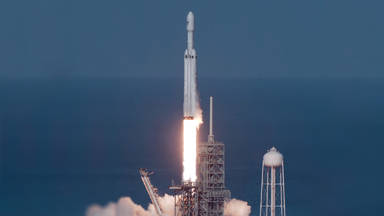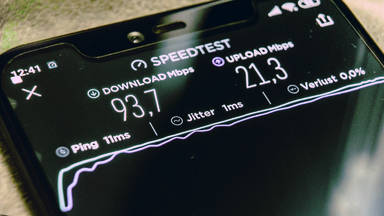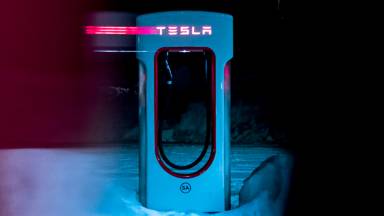
SpaceX launched a Falcon 9 rocket with 60 satellites on May 24th. This was the start of their ambitious new project called Starlink, which aims to provide high-quality broadband Internet to the most remote parts of the world, as well as connect to already well-connected, low-latency cities.
SpaceX aims to make broadband access as good as possible, arguing that anyone will be able to connect to their network by purchasing the pizza-box-sized antenna developed by SpaceX itself.
This launch of 60 satellites was only the first of many. SpaceX has scheduled 12,000 satellite launches for the next decade, dramatically increasing the total number of satellites around Earth's orbit. This will cost SpaceX billions of dollars, so they must have a good reason to do so.
Let's see how this network works and how it competes with existing Internet providers.
In 2015, Elon announced that SpaceX had begun work on a satellite communications network, and stated that there was a significant unmet need for cost-effective global broadband capabilities. At that time, SpaceX opened a new department in Redmond, Washington to develop and produce these new communications satellites.
The original plan envisaged the launch of two satellite prototypes in orbit by 2016 and the implementation of the first satellite constellation by 2020. However, the company attempted to develop a receiver that could be easily and inexpensively installed by the user. This delayed the program and the first satellite prototypes were launched in 2018.
Following the successful launch of the two prototypes Tintin-A and B, which allowed SpaceX to test and refine the design of its satellites, SpaceX remained pretty quiet until November 2018, which was followed by the Starlink project getting approved by the FCC for the distribution of 7,500 satellites in orbit, in addition to the 4,400 already approved satellites.
On May 24, the first group of production satellites began orbiting and people around the world quickly began to identify the satellite train moving through the night sky.
This launch is a precursor of things to come while this first group of satellites is not fully functional yet, it will be used to test things like terrestrial communication systems and krypton engines that are used to self debris and de-orbit vehicles too avoid once it reaches the end of its life cycle.
Xenon is ideally used because it has a high atomic mass, which allows it to provide more calcium per atom while being inert and has a high storage density which in the long run is suitable for storage on a spacecraft. However, SpaceX chose krypton because xenon is a much more expensive propellant because of its rarity.
With this ion propulsion system, the Starlink satellites are initially raised from their runways to 440 km to their final orbit altitude of 550 km. They are also used in combination with the motion control gyroscopes installed here and the US space-junk collision prediction system to enable satellites to adjust their collision avoidance orbits.
When satellites reach the end of their life, they can de-orbit the satellite using the same attitude and engine controls. SpaceX has included all the hardware required to minimize the risk of space debris. In their request for approval by the Federal Communications Commission, they claimed that 95% of the satellite will burn on their re-entry.
Only the silicon carbide components could survive because they are crucial elements for the operation of the lasers and therefore have an extremely high melting point of 2,750 ° C. This brings us to our communication capabilities, the main function of the satellite.
SpaceX has been quiet about most details of the satellite, but thanks to the FCC approval application, we know that the satellites will contain 5 x 1.5 kilograms of silicon carbide components, indicating that each satellite will contain 5 individual lasers. These lasers, like our fiber optic cables here on Earth, use pulses of light to transmit information between satellites.
However, the transmission of light in space offers a great advantage over light transmission here on Earth. The speed of light is not constant for every material. In fact, light in glass moves 47% slower than in the vacuum.
This gives Starlink a huge advantage, which is likely to be the most important money-maker. It offers the potential for low-latency information over a long distance.
To simplify, consider it as a run between data packets. A London user would like to receive the new adjusted price of a stock on the NASDAQ from the New York Stock Exchange. If a typical route was used for this information, it has a round trip distance of approximately 12,800 kilometers through a fiber optic cable.
In a vacuum, the light moves at a speed of 299,792,458 m/s. The speed of movement in the glass depends on the refractive index and the refractive index on the wavelength, but we take the reduction to 1.47 times the speed of light in a vacuum (203940448 m/s).
This means that the data packet needed to complete the round trip takes about 0.063 seconds and therefore has a latency of 0.063 seconds or 62.7 milliseconds.
With the extra steps added to this latency, such as converting the light signals into electrical signals at both ends of the optical cable, the traffic queues and the transmission to the terminal of the final computer, this total time is approximately 76 milliseconds.
Calculating Starlink latency is much more difficult because we do not have any real measurements, but with the help of Mark Handley, a professor of communications at University College London, we can make some plausible hypotheses.
The first source of latency for Starlink is the uplink and downlink process, where we need to transfer our information from and to Earth. We know that this will happen with the phase alignment antenna, which is a radio antenna that can control the direction of transmission without moving parts. Instead, they use destructive and constructive interference to control the direction of the radio wave.
Each satellite has a cone beam with a field of view of 81 degrees. In an orbit of 550 kilometers, each satellite can cover a circular area with a radius of 500 km.
On the originally planned orbit of SpaceX, this cover had a radius of 1060 kilometers. Decreasing the height of a satellite will reduce the range it can cover but it also reduces the latency.
This is particularly evident in typical communications satellites operating in a geostationary orbit at a height of approximately 36,000 kilometers.
However, since Starlink intends to operate at a much lower altitude, the theoretical latency of the uplink and downlink could only be 3.6 ms. That's why SpaceX needs so many satellites in its constellation to provide global coverage.
Every single Starlink satellite has a four-phase array antenna. This directional beam was an essential part of the SpaceX FCC approval application, as thousands of satellites transmitting undirected radio waves would significantly disrupt other communication methods.
Once data has been received by one Starlink satellite, this data can be transmitted between satellites using lasers.
Every time we hop from satellites, there is a small delay as the laser light is converted to an electrical signal and back again, but it is too small to be considered.
Things become difficult with the use of lasers because we need to exactly hit the receiver on the nearby satellites to transmit that data. Let's take a look at SpaceX's proposed constellation to see how it will work.
The first phase of X space with 1584 satellites will occupy 24 orbits with 66 satellites in each plane tilted 53 degrees. The communication between neighbor satellites in the same orbital plane is relatively simple as these satellites remain in relatively stable positions with respect to each other.
In this way, we obtain a solid line of communication along a single orbital plane. In many cases, however, two positions are not connected by a single orbital plane, so we also need to be able to transfer information between these levels.
This requires accurate tracking as the satellites flying to nearby orbits fly and go in and out incredibly fast. This means that the Starlink satellite has to switch to a new satellite in the network.
Starlink has 5 built-in optical communication systems to maintain a stable connection to 4 satellites at all times.
Now, if we use this system and send data using the shortest route from New York to London and vice versa, using the speed of light in vacuum as the transmission speed, we can achieve a "latency" of just 43 milliseconds.
Even if we had done the shortest possible journey with fiber that does not exist, it would take about 55 milliseconds, which means a 28% decline in speed.
If we put the theoretical shortest-path aside, the current roundtrip time for the real-life scenario is about 76 milliseconds, which is a 77% drop in speed.
In fact, it would not be the first time that a communications company has made massive investments to service these groups. The Hibernian Express cable is a privately owned optical cable that is currently the lowest latency connection between the NY4 data center in Secaucus, New Jersey and the LD4 data center in Slough, England at just 59.95 milliseconds, which is 39.4% slower than our best time with Starlink.
The previous best time was owned by the 65 millisecond AC-1 cable. At a cost of 300 million dollars, this 5-millisecond speed increase was justified only for the connection across the Atlantic.
Imagine how much these time-sensitive industries are willing to pay for a 17-millisecond increase in speed. It will be even more valuable if you find that this time-difference rises with extending the transmission distance. New York to London is a relatively short distance.
The improvements would be even clearer with a transfer from London to Singapore, for each additional kilometer we can see the possible speed gains more in effect.
However, SpaceX isn't planning to make this super-fast Internet only available to a few customers, but it is also using this system to help connect everyone on the planet to the Internet. In addition to that main purpose, enough bandwidth will be available for these customers.
Although the Internet was one of the fastest growing technologies in human history, more than half of the world's population (4 billion) will still be offline by the end of 2019.
Users will be connected to the Internet via a Starlink terminal, which costs around $200 each. While still far outside the purchasing power of many Third World citizens, this is a start and much cheaper than the similar receivers currently available, such as the Kymeta version for $30,000.
It is estimated that switching from a 4G wireless connection to a 5G connection in the next 7 years will cost around $150 billion for fiber optic cabling alone. SpaceX plans to complete its entire Starlink project for as little as $10 billion.
Each Starlink satellite costs approximately $300,000 which already draws a huge cost saving for communications satellites. SpaceX also saves on launch costs by launching on their own Falcon 9 rocket. While no other satellite manufacturer has such an option.
Based on premium market share, Starlink is estimated to generate $30 billion a year in revenues, demolishing its current annual income (approximately $3 billion).
This is a vital part of Elon Musk's long term goals. The money generated by Starlink means that SpaceX will have greatly more funding than NASA which could go on to fund the research and development of new rockets and the technology needed to monetize lunar and Mars colonies.
For now, the project connects the world even more and potentially opens educational channels for Third World countries that do not have adequate internet connectivity. The widespread internet helps to solve this problem.
READ MORE: SpaceX Lost Connection With 3 Starlink Satellites









